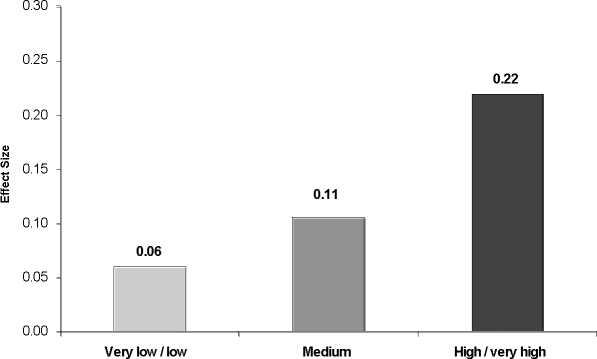3. Pre-school Centre Effectiveness
During the pre-school phase of the research we analysed children’s cognitive progress from age
3 to rising 5 years (till the start of primary school). These analyses provided measures of centre
effectiveness (see Sammons et al., 2002). We analysed these measures of centre effectiveness
in the same way as those for quality. In these analyses pre-school centre effectiveness, in terms
of promoting progress in Pre-reading, was tested as a potential predictor for later Reading
attainment in Year 5 of primary school education, and pre-school effectiveness, in terms of
promoting progress in Early number concepts, was tested as predictor for later Mathematics
skills.
Controlling for child, family and HLE influences, we find that measures of pre-school centre
effectiveness still show a positive net impact on children’s subsequent attainment in both
Reading and Mathematics in Year 5 (see Figure 3.3 for the impact of pre-school effectiveness on
attainment in Mathematics). Children who had attended a more effective pre-school setting also
show significantly better attainment than children who had attended none or only a low effective
pre-school setting.
Figure 3.3: The impact of pre-school effectiveness on attainment in Mathematics at Year 5
The Net Impact of Pre -School Effectiveness (Early
Numbers) on Attainment in Mathematics in Year 5

Pre-School Effectiveness
Reference Group:
‘Home Children ’
Net effects are notably stronger for Mathematics: Compared to the ‘home’ group, children who
went to high or very highly effective pre-schools have significantly higher attainment at the end of
Year 5. Thus, the effectiveness of the pre-school setting appears to be relatively more important
for this cognitive outcome than for Reading in Year 5.
4. The Combined Impact of Early Years Home Learning Environment (HLE) and Pre-
School Experience
We have already demonstrated modest continuing effects for the quality and effectiveness of
pre-school experience and strong effects for the early years HLE in Key Stage 1 (see EPPE
Sammons et al., 2004a; 2004b) and now in Year 5. Further analyses were used to investigate
their joint effects. For this analysis the HLE index was regrouped into three categories
representing low, medium and high HLE.
16
More intriguing information
1. The name is absent2. The name is absent
3. Pursuit of Competitive Advantages for Entrepreneurship: Development of Enterprise as a Learning Organization. International and Russian Experience
4. Competition In or For the Field: Which is Better
5. NEW DEVELOPMENTS IN FARM PRICE AND INCOME POLICY PROGRAMS: PART I. SITUATION AND PROBLEM
6. Evolution of cognitive function via redeployment of brain areas
7. AGRIBUSINESS EXECUTIVE EDUCATION AND KNOWLEDGE EXCHANGE: NEW MECHANISMS OF KNOWLEDGE MANAGEMENT INVOLVING THE UNIVERSITY, PRIVATE FIRM STAKEHOLDERS AND PUBLIC SECTOR
8. Consumption Behaviour in Zambia: The Link to Poverty Alleviation?
9. Deprivation Analysis in Declining Inner City Residential Areas: A Case Study From Izmir, Turkey.
10. A Computational Model of Children's Semantic Memory